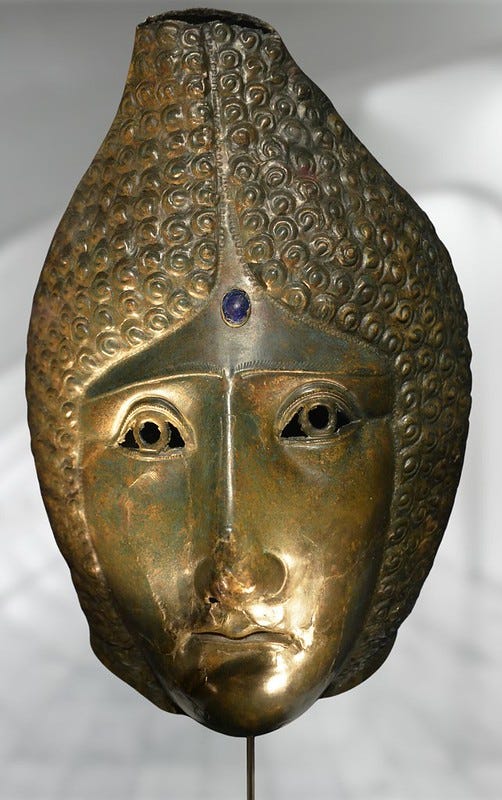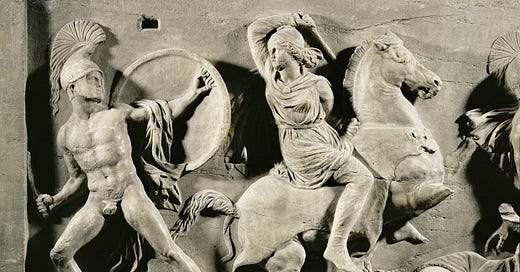Amazons: how female warriors fought on Hadrian's Wall
Once believed imaginary, remains of fabled women soldiers who patrolled for Empire from 200 AD found in Cumbria
Amazons were once believed to be purely mythical beings.
In Greek and Roman legends, they were portrayed as a race of beautiful female warriors. They surpassed men in agility, strength, archery, riding skills and the arts of combat.
They were supposed to be the archenemies of the ancient Greeks. Every fictional hero, from Hercules to Achilles, had to prove his mettle by fighting the powerful queen of the Amazons.
The Greeks believed these fierce, horse-riding women came from exotic lands that lay to the northeast of Greece. That is an area that many researchers now think corresponded with Scythia — a vast territory stretching roughly from north of the Black Sea in the west to Mongolia in the east.
Some of the tales about Amazons were frankly shot through with outrageous misogyny. Mythology suggested that they cut off their breasts to fire their bows better. They didn’t.

Another widely - touted story was that they were man-haters who mutilated or killed their boy children. Even Greek historians dismissed that allegation as ridiculous.
But now there is evidence that Amazons were real and that they fought and died in Cumbria.
So, let’s take a journey back to the time when the female horse warriors were recruited to the Roman army and served on Hadrian’s Wall.
The reason for embarking on this fictional trip is that a female archaeologist called Dr Hilary Cool has made an extraordinary discovery.
She was invited to analyse some bones that were dug up in 1966 at a cemetery attached to Brougham Roman fort in Cumbria.
What Dr Cool discovered is quite astonishing. Her analysis suggests that Amazons - female horse warriors from Scythia previously thought to be mythical - actually existed and did serve at Brougham fort between 200 and 310 AD.
Her discovery also indicates that women warriors died fighting in the borderlands around Hadrian’s Wall. Her analysis shows they were ritually cremated in a special cemetery set aside for Scythian troops whose burial practices differed markedly from the standard Roman funery rites.
The bones Dr Cool examined had never been properly analysed. They had lain in sample boxes ever since they were dug up. She did not have the remotest idea that this routine task would result in her turning classical history on its head. The first part of what follows is an imaginative reconstruction, not a precise history. It recounts a skirmish similar to one in which the Amazons took part near the wall. It happened on the road between Penrith and Carlisle in the year 206 AD.
The rest of this piece is an account of the remarkable findings of Dr Cool’s archaeological investigation of the actual remains buried after the event.
Imagine you are a character in this story. You find yourself driving a four-wheeled open cart pulled by two ponies. It is filled with iron ingots cast at the mines that the Romans established in Dunelm (Durham). You are heading west in the direction of Luguvalium (Carlisle).
It’s been rough going, mostly over gravel, but often clattering along cobbled roads. Your cart has no suspension. You have been told the heavy cubes of iron are needed because the army smiths are manufacturing more scale armour in Luguvalium. The extra protection has been ordered because the disgusting Picti, the blue-painted barbarians who live north of the wall, are rising up.
You know that your mission to deliver this metal is very dangerous. The barbarians haven’t got much iron to make weapons with and they value it more than gold. So, they will take it off you if they can with extreme violence if necessary. “Nē vōs quidem mortem timueritis,” (nor must you fear death) the soldiers told you. You didn’t want to go, but you weren’t given a choice.
The Roman army is the law and it can make life very difficult if you don’t go along with what it wants. Behind you in the far distance the twin towers of Brocavum (Brougham) fort are receding. All around you is golden saxifrage, bog bilberry, hawthorn.
You and the other drivers dossed down overnight inside Brougham fort’s walls. You celebrated getting over Stainmore pass alive. They served you posca – vinegary wine mixed with water and herbs made from the fourth pressing of the grapes. It’s the stuff they give to the slaves. Ugh.
When the sun rose, you trotted out of the fort and over the bridge with a flashy new escort of cavalry soldiers jingling all around. You have carefully placed your cart in the middle of the procession for safety.
You know that security on the Wall has gone to hell since the would-be usurper Clodius Albinus decided he wanted to be Emperor. He took three legions, about 150,000 troops, from Britannia and crossed to Gaul three years ago. That left the wall pretty well undefended.
He was an idiot to challenge that ruthless Septimius Severus for the emperorship. Albinus killed himself at Lugdunum (Lyon) when his coup failed.
After all the upheaval there aren’t enough men to fill the gaps in Hadrian’s great barrier. It was only made of wood and turf in parts anyway. Now it is a century old and it is falling apart. The wretched brittunculi have been hopping over it in droves. They have been killing Romans, chopping up the corpses and taking the heads back to shove on spikes outside their filthy hovels.
You have to admit the Brits are good fighters, though. You have heard that Severus has ordered the new governor, Alfenus Senecio, to rebuild the Wall. There’s an enormous amount of work going on.
He’s strengthened the rampart at Petuaria (Brough) and he is constructing a granary at Coria (Corbridge) to feed more auxiliaries, if they can find any. There are stone inscriptions going up all over the north saying “Senecio restored this.” Senecio has won some battles against the Caledonians.
He put up a victory monument at Condercum (Benwell). You think he’d better watch out. The emperor will be getting jealous.
At least Severus is not afraid to spend money. But there are loads of complaints that he has taken silver out of the coins to pay for all the building work and prices are going up. Anyway, you think a bit of new masonry won’t be enough. They say Severus won’t let Senecio hog all the glory. He will have to come to Britannia himself pretty soon with enough legionaries to show the Caledonians some of his famous severity.
Impressive, but funny-looking lot, this cavalry.
The Numerus Equitum Stratonicianorum, they call them. From Scythia. You have never seen anything like them before. This patrol has the usual number of horse warriors, thirty, all with standard-issue swords and throwing spears. But what’s different about this lot is they carry superbly well-made bows and gold-tipped arrows lodged in beautiful, gilded leather sheaths slung around their shoulders.
The gossip is that the Sacae (Scythians) come from somewhere north of where the Hellenes (Greeks) live. That’s in the barbaricum, outside the empire. We have been using barbarian cavalry like these people to protect the empire for a century. Apparently, our own citizens aren’t good enough at being horsemen.
That said, you think these horse troops look very relaxed and extremely comfortable on their chunky little ponies. It’s almost as if they were born on horseback. You saw many of them walking around the fort, looking comically bow-legged.
They spend so long on horseback that dead Sacae get buried sitting up, some say. Anyway, now they are riding along beside your iron carts all wearing their funny padded trousers and long-sleeved wool tunics with colourful zig-zag patterns on them in red and green. They wear mail coats on top and they have a weird, high pointed caps on their heads to protect them from the rain. You saw at the fort that they have tattoos on their arms and legs. You saw one with a deer on his right shoulder and dots on his left wrist.
Occasionally, they pull out a little hand mirror and look at themselves. Several of them check their beards. The ones that don’t have beards are wearing beads. They are women! So, it is true. There are women in the Roman Army. You have never seen this before. One of the women is really statuesque. She’s out at the front of the trotting column. She’s clearly the officer. She is absent-mindedly stroking her hair, checking her braid is in place. So, the column is nearing the most dangerous part of this journey, halfway between Brocavum and Voreda (Old Penrith) forts. Suddenly, out of the woods on the hillside to the right, there is a terrible din.
What looks like viginti (twenty) two-wheeled chariots burst out of the trees pulled by small, swift horses. On each of them is a Briton holding the reins of two flowing-maned narrow-bodied geldings. They are firm in hoof and harness, powerful, lithe and swift-leaping. Standing on the chariot platforms behind the drivers, are horrible, blue-painted warriors with shields and weapons. They’re wearing enormous bronze helmets with animal designs embossed on the peaks. They are screaming. The noise of their wheels is deafening. It’s so confusing. The chariots are driving all over the field this way and that hurling javelins at you. Your cavalry escort is momentarily in disarray.
This is an extract based on a chapter from a new book, The Trophy at the End of the World. You can buy it instantly here:
: https://www.fletcherchristianbooks.com/product/the-trophy-at-the-end-of-the-world
Or you can pick up a copy from the New Bookshop, Main Street, Cockermouth, Bookends in Keswick or Carlisle and Sam Read in Grasmere.
Keep reading with a 7-day free trial
Subscribe to Hidden Cumbrian Histories to keep reading this post and get 7 days of free access to the full post archives.





